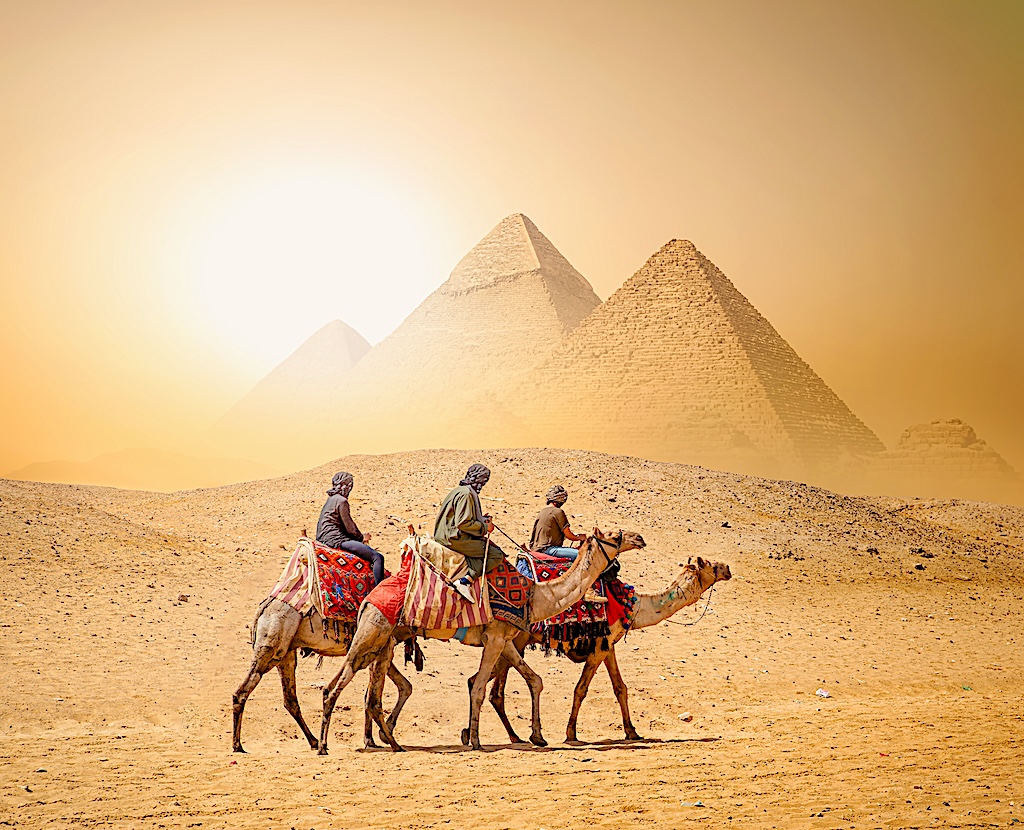Egypt is considered one of the oldest nations in human history and is often referred to as the “Mother of the World” due to its prominent place in global civilization. Geographically, it lies in the northeast of Africa, yet the Sinai Peninsula connects it to Asia, giving it a unique strategic position as a civilizational bridge between the two continents.
The Nile River, the longest river in the world, flows through its lands and has always been the main source of life and agriculture for thousands of years, playing a vital role in the development of Egyptian society throughout history.
Egypt is the cradle of Ancient Pharaonic Civilization, which amazed humanity with its achievements in architecture, engineering, science, and astronomy. Its material legacy — the Pyramids, the Sphinx, and the temples of Karnak and Luxor — still stand today as testimony to the genius of the ancient Egyptians. Egypt also retained a central position during the Greek, Roman, and Islamic eras, serving as a hub for culture and science. The Al-Azhar University remains one of the oldest educational institutions in the Islamic world, continuing its mission of spreading knowledge and preserving Islamic identity.
In the modern era, Egypt maintains a significant influence in both the Arab and African worlds. It is one of the most populous Arab nations and plays a leading role in the Arab League, often mediating in major regional issues. Its economy is notably diverse, combining agriculture along the Nile Valley, industry, and tourism — the latter being one of the main pillars of its national economy.
Culturally, Egypt is known for its pioneering role in Arabic arts, which have shaped the cultural consciousness of the Arab world. It is also a global tourist destination, attracting visitors with its historical monuments and natural beauty, including the beaches of Sharm El-Sheikh and Hurghada, as well as the historical sites of Aswan and Luxor.
In summary, Egypt remains a living example of civilizational and cultural interaction across the ages, and its contributions to human history and culture continue to shine to this day.
تُعَدُّ مِصْرُ وَاحِدَةً مِنْ أَعْرَقِ الدُّوَلِ فِي التَّارِيخِ الإِنْسَانِيِّ، وَيُشَارُ إِلَيْهَا غَالِبًا بِلَقَبِ “أُمُّ الدُّنْيَا” نَظَرًا لِمَكَانَتِهَا البَارِزَةِ فِي الحَضَارَةِ الإِنْسَانِيَّةِ. تَقَعُ جُغْرَافِيًّا فِي شِمَالِ شَرْقِ قَارَّةِ أَفْرِيقِيَا، إِلَّا أَنَّ شِبْهَ جَزِيرَةِ سِينَاءَ تَرْبِطُهَا جُغْرَافِيًّا بِآسْيَا، مِمَّا يُمْنِحُهَا مَوْقِعًا اسْتِرَاتِيجِيًّا فَرِيدًا كَجِسْرٍ حَضَارِيٍّ بَيْنَ القَارَّتَيْنِ.
وَيَمُرُّ فِي أَرَاضِيهَا نَهْرُ النِّيلِ، الَّذِي يُعَدُّ أَطْوَلَ أَنْهَارِ العَالَمِ، كَمَا كَانَ وَمَا زَالَ المَصْدَرَ الأَهَمَّ لِلْحَيَاةِ وَالزِّرَاعَةِ مُنْذُ آلَافِ السِّنِينَ، وَرَافِدًا رَئِيسِيًّا لِتَطَوُّرِ المُجْتَمَعِ المِصْرِيِّ عَبْرَ العُصُورِ.
مِصْرُ هِيَ مَهْدُ الحَضَارَةِ الفِرْعَوْنِيَّةِ القَدِيمَةِ الَّتِي أَبْهَرَتِ الإِنْسَانِيَّةَ بِإِنْجَازَاتِهَا فِي مَجَالَاتِ العِمَارَةِ وَالهَنْدَسَةِ وَالعُلُومِ وَالفَلَكِ، وَيَظَلُّ الإِرْثُ المَادِّيُّ المُتَمَثِّلُ فِي الأَهْرَامَاتِ وَأَبُو الهُولِ وَمَعَابِدِ الكَرْنَكِ وَالأُقْصُرِ شَاهِدًا حَتَّى اليَوْمِ عَلَى عَبْقَرِيَّةِ الإِنْسَانِ المِصْرِيِّ القَدِيمِ. كَمَا احْتَفَظَتْ مِصْرُ بِمَكَانَةٍ مَرْكَزِيَّةٍ فِي العُصُورِ الإِغْرِيقِيَّةِ وَالرُّومَانِيَّةِ وَالإِسْلَامِيَّةِ، حَيْثُ كَانَتْ مِحْوَرًا لِلثَّقَافَةِ وَالعُلُومِ، وَلا تَزَالُ جَامِعَةُ الأَزْهَرِ إِحْدَى أَعْرَقِ المُؤَسَّسَاتِ التَّعْلِيمِيَّةِ فِي العَالَمِ الإِسْلَامِيِّ، تُوَاصِلُ دَوْرَهَا فِي نَشْرِ العُلُومِ وَالحِفَاظِ عَلَى الهُوِيَّةِ الإِسْلَامِيَّةِ.
أَمَّا فِي العَصْرِ الحَدِيثِ، فَإِنَّ مِصْرَ تَحْتَفِظُ بِتَأْثِيرٍ بَارِزٍ فِي العَالَمَيْنِ العَرَبِيِّ وَالأَفْرِيقِيِّ، فَهِيَ مِنْ أَكْبَرِ الدُّوَلِ العَرَبِيَّةِ مِنْ حَيْثُ عَدَدُ السُّكَّانِ، وَتَلْعَبُ دَوْرًا رَئِيسِيًّا فِي جَامِعَةِ الدُّوَلِ العَرَبِيَّةِ، كَمَا تَبْرُزُ فِي الوَسَاطَاتِ السِّيَاسِيَّةِ فِي العَدِيدِ مِنَ القَضَايَا الإِقْلِيمِيَّةِ. وَيَتَّسِمُ الاقْتِصَادُ المِصْرِيُّ بِتَنَوُّعٍ مَلْحُوظٍ، حَيْثُ تَجْمَعُ الدَّوْلَةُ بَيْنَ النَّشَاطِ الزِّرَاعِيِّ فِي وَادِي النِّيلِ، وَالصِّنَاعَةِ، وَقِطَاعِ السِّيَاحَةِ الَّذِي يُعَدُّ مِنَ الأَعْمِدَةِ الأَسَاسِيَّةِ لِلاقْتِصَادِ الوَطَنِيِّ.
ثَقَافِيًّا، تُعْرَفُ مِصْرُ بِدَوْرِهَا الرِّيَادِيِّ فِي الفُنُونِ العَرَبِيَّةِ الَّتِي أَثَّرَتْ فِي وَجْدَانِ المُجْتَمَعَاتِ العَرَبِيَّةِ. كَمَا تُعَدُّ مِصْرُ مَقْصِدًا سِيَاحِيًّا عَالَمِيًّا، بِفَضْلِ مَا تَحْتَوِيهِ مِنْ آثَارٍ تَارِيخِيَّةٍ وَمَنَاظِرَ طَبِيعِيَّةٍ خَلَّابَةٍ، مِثْلَ شَوَاطِئِ شَرْمِ الشَّيْخِ وَالغَرْدَقَةِ، وَالمَوَاقِعِ التَّارِيخِيَّةِ فِي أَسْوَانَ وَالأُقْصُرِ.
وَاخْتِصَارًا، تَظَلُّ مِصْرُ مِثَالًا حَيًّا عَلَى التَّفَاعُلِ الحَضَارِيِّ وَالثَّقَافِيِّ المُمتَدِّ عَبْرَ العُصُورِ، وَتَبْقَى مُسَاهَمَاتُهَا الحَضَارِيَّةُ وَالثَّقَافِيَّةُ حَاضِرَةً بِقُوَّةٍ فِي التَّارِيخِ الإِنْسَانِيِّ حَتَّى يَوْمِنَا هَذَا.
https://forms.gle/5dDVhrNsEiozW7Qk9 اختبر نفسك
Test yourself https://forms.gle/N6w72qjUnseJ8yFZA

